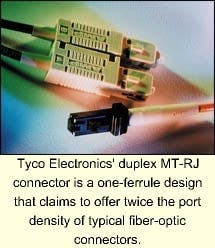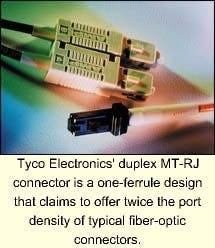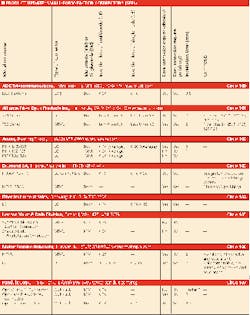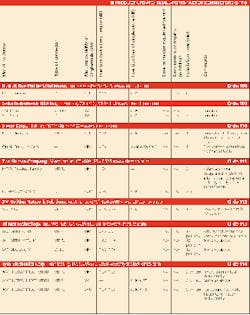Michelle Abrams
Countless engineers channel their energy into developing new technologies to make field installations faster and easier while accommodating a wider range of installers. But when it comes to fiber installations, it is not only speed of installation that matters, it's the cost. And the necessity for a faster, cheaper, easier fiber connections tool helped give birth to the small-form-factor (SFF) connector.
The SFF is not only smaller but it allows for at least twice as many connections. SFFs are much smaller than traditional fiber connectors, hovering around the size of a modular 8-pin connector used with Category 5 copper cable. There are six styles of SFFs: MT-RJ, LC, VF45, LX.5, Opti-Jack and SCDC-SCQC. Within these styles are a range of types, including connectors that require epoxy and polishing.
"The market is truly in its infancy," says Paul Leslie, product manager for ADC (Minneapolis, MN). Communications equipment being used today demands more fiber capabilities, making SFF connectors desirable.
The standards debate
There has been considerable debate within the EIA/TIA standards committee over which connector should be the standard for fiber optic connections. In fact, EIA/TIA 568 B.3 doesn't specify a specific connector design, noting that any design is acceptable so long as the connector possesses a FOCIS (Fiber Optic Connector Intermateability Standard) document.
Of the companies responding to our SFF survey (see Product Update, page 56), the MT-RJ connector is by far the most widely manufactured. It is perhaps no surprise then that the MT-RJ received 59% of the standards' committee vote as a solution to replace the SC connector, falling just short of the two-thirds majority needed to make it official.
AMP, now Tyco Electronics (Harrisburg, PA), is responsible for the original design of the MT-RJ. Its duplex connector consisting of a molded body with two fibers spaced 750 microns apart is a one-ferrule design. The ferrule design is based on multi-fiber ferrules designed to hold a maximum of 12 multi- or singlemode fibers, and it offers twice the port density of traditional fiber-optic connectors.
Herb Congdon, marketing manager for fiber systems at Tyco Electronics, says "We take a short fiber stub, epoxy it in the ferrule and polish it at the factory," he says. "All an installer has to do is slide the fibers into position and clamp the connector into place."
LC makes gains
Another popular SFF is the LC, a product of Avaya Labs (formerly Bell Labs), released in 1997-a versatile, multi-purpose connector that resembles a miniature SC with a duplex design, ceramic ferrule and plastic body. The LC's distinguishing feature is that each fiber is aligned separately.
LC connectors are designed for field installation with either epoxy or anaerobic adhesive. There are also no epoxy/no polish designs, such as Avaya's "LC quick crimp." Designed to be a high-performing connector, the LC is expected, according to Avaya, to meet future needs such as operation at gigabit speeds.
While Avaya first pioneered the LC, several companies have since obtained licensing agreements. Alliance Fiber Optic Products Inc. (Basking Ridge, NJ) manufactures both the LC and MT-RJ. David Hubbard, vice president of sales and marketing, observes that the LC and MT-RJ will be leading the market forward, and companies such as Alliance are introducing new applications for both styles. One such application from Alliance is a quad-LC adapter that lets the LC fit into areas previously designed for the SC connector.
Born in a garage
In contrast to the labs of Avaya, the VF45, also known as the 3M (Austin, TX) Volition, was born in a garage to specifically target LANs. "I worked evenings in my garage because I was fed up with ferrule connectors," says 3M's Global Ambassador of Innovation, Jim Bylander. One day, as Bylander was walking into a meeting, he noticed an installer placing a traditional fiber-optic connector into a telecommunications closet. Sometime later, as the meeting adjourned, the installer was still working on the same connector. It was this moment that Bylander realized the need for a connector that is not only easy but quick to install.
The result is a no-ferrule design with "v-grooves" in place of an alignment ferrule. The VF45 consists of six to seven parts compared to the 15 or so used to construct the SC, and the installation time is eight to ten times less.
The VF45's unique jack and plug design replaces the two plugs and coupling that Bylander observed on many other SFFs. This, he says, gives the VF45 an advantage of simplicity, speedier installation and lower cost over other connectors.
The newest player in the SFF market is the LX.5, which was introduced in 1998 by ADC. Development was "driven by the need to deploy more fibers in a given footprint," says ADC's Leslie. The LX.5 is a singlemode, angle-polish connector with one ferrule that measures 1.25 mm in diameter.
The LX.5 adapter fits into the exact same footprint as the SC, yet ADC says the LX.5 reduces costs by providing two connections where only one was available with the SC.
"The contractors we work with found that they take more time installing LX.5s," says Leslie. "But they are very confident that the connector is good and will not have to be replaced in five years."
Opti-Jack plugging away
Considered the oldest SFF design, Panduit's Opti-Jack has carved its own small niche in the SFF market. It is a duplex SFF, built around a regular zipcord cable, with a plug/jack configuration. The two-ferrule design is manufactured as a standard SFF requiring both epoxy and polishing, an adhesive version that does not require polishing, and the most recent version-launched in November 2000-requiring no epoxy or polishing.
Opti-Jack is especially suited for fiber-to-the-desk applications. Compared to other connectors, such as the VF45, Panduit claims the Opti-Jack is more stable because considerably more material surrounds the connector to protect it from abuse at the desktop.
The SCDC-SCQC. meanwhile, is one of the least discussed SFF connectors. Originally developed by Siecor, it is now a product of Corning Cable Systems (Hickory, NC). It is a "cleave and leave" type connector that resembles the SC with two or four fibers in a line across the end of a standard 2.5 mm ceramic ferrule.
Selection questions
So, how do you choose one SFF over another? With so many options, there are several questions you should ask:
- Is it available in both single and multimode? The majority of SFF are multimode but singlemode will eventually become dominant.
- What is the condition of the fiber? Bylander remarks that the condition of the fiber should determine whether you want to use a SFF with or without a ferrule.
- Will it be field-terminable? When selecting connectors for areas where there will be a plethora of connections, such as the telecom closet, one that requires epoxy may make sense because the time it takes to set up for the installation process will be justified by the time saved in installation.
- Where will the SFF be used? It is also important to choose your SFF based on where you'll use it. For instance, Bylander stresses that VF45s are not made for outdoor installation.
Once these questions are answered, other factors, such as cost, must be taken into consideration. Tyco Electronics' Congdon cautions that you have to balance the connector cost with the cost of labor to determine the best option.
What's ahead
ADC's Leslie expects "phenomenal growth over the next ten years." It is even rumored that another SFF is in development by NTT (Japan) called the MU, which is a cross between a miniature SC connector and Avaya's LC connector.
Fiber-to-the-desk is expected to be the "new frontier" for SFF connectors, but Avaya's fiber optic manager, Louise Bryant, believes that while fiber-to-the-desk is going to be increasingly important, cost will play a major role.
While the majority of installations are done in lower-cost copper, Bryant notes that copper will not be able to support future high-end applications, forcing a transition to fiber. And, she says, manufacturers of SFFs will need to be more conscious of costs to facilitate these transitions.
null
null



